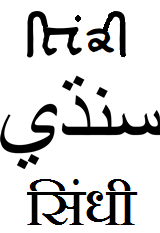Difference between revisions of "Language/Sindhi/Grammar/Passive-Voice"
m (Quick edit) |
m (Quick edit) |
||
| Line 110: | Line 110: | ||
<span gpt></span> <span model=gpt-3.5-turbo></span> <span temperature=1></span> | <span gpt></span> <span model=gpt-3.5-turbo></span> <span temperature=1></span> | ||
==Videos== | |||
===Complete passive voice course in sindhi | Concept of passive voice ...=== | |||
<youtube>https://www.youtube.com/watch?v=kBJ8i7R3dPg</youtube> | |||
===Active and passive voice tense exercise | in sindhi | passive voice ...=== | |||
<youtube>https://www.youtube.com/watch?v=Ctopuq98xXk</youtube> | |||
===All passive voice tense in one class | in sindhi | مڪمل پيسئو وائيز ...=== | |||
<youtube>https://www.youtube.com/watch?v=e3YiNKRkTww</youtube> | |||
{{Sindhi-Page-Bottom}} | {{Sindhi-Page-Bottom}} | ||
Revision as of 20:54, 2 April 2023
Introduction
Welcome to the advanced grammar section of the Complete 0 to A1 Sindhi Course. In this lesson, we will learn about the Passive Voice in Sindhi. The passive voice is used when the focus is on the action. Instead of focusing on who or what is performing the action, the focus is on the action itself. For example, "The book was read by the student" is a passive sentence where the focus is on the book being read rather than who read the book. In this lesson, we will learn how to form passive sentences in Sindhi, including changing active sentences to passive and using passive verbs.
Forming Passive Sentences in Sindhi
The passive voice is formed by using the verb "جو" (jo) in Sindhi. This is how you form a passive sentence in Sindhi:
- Put the object of the active sentence as the subject of the passive sentence.
- Put the verb "جو" (jo) after the object.
- Use the past participle form of the main verb.
- If needed, add the agent of the verb with the preposition "وارِ" (war).
Let's look at an example:
Active sentence: شہزادو شعر سڄي ٿيو. (Shahzado shaer suchi thiyo.) - Shahzad wrote a poem. Passive sentence: شعر جو شہزادو سڄي ٿيو. (Shaer jo Shahzado suchi thiyo.) - The poem was written by Shahzad.
In the passive sentence, شعر (shaer) which means "poem" is the object in active voice that becomes the subject in passive voice. The verb "ٿيو" (thiyo) was changed to "جو" (jo) and the agent "شہزادو" (Shahzad) was added with the preposition "وارِ" (war).
Changing Active Sentences to Passive Sentences
To change an active sentence to a passive sentence, follow these steps:
- Identify the object of the active sentence.
- Make it the subject of the passive sentence.
- Use the appropriate form of the verb "جو" (jo) after the object.
- Use the past participle of the main verb instead of the present or past tense.
- Add the agent of the verb with the preposition "وارِ" (war) if necessary.
Here is an example:
Active sentence: پنجهير پيار aهيو ٿيو. (Panjhir payar ahiyo thiyo.) - The pigeon loved the peas. Passive sentence: پيار جو پنجهير aهيو ٿيو. (Payar jo panjhir ahiyo thiyo.) - The peas were loved by the pigeon.
In the passive sentence, "پيار" (payar) is the object in active voice that becomes the subject in passive voice. The verb "ٿيو" (thiyo) was changed to "جو" (jo). No agent was used in this example.
Using Passive Verbs in Sindhi
Passive verbs are verbs that show the subject receiving the action instead of performing the action. In Sindhi, passive verbs are formed by using the verb "جو" (jo) and the root form of the verb. The passive verb is then conjugated to match the gender and number of the subject. Here is an example:
Verb: لڏيو (ladhyo) - to find Passive verb: لڏي جو (ladhy jo) - to be found
Conjugation of the passive verb:
| Person | Singular | Plural |
|---|---|---|
| First Person | لڏي جون (ladhy jon) | لڏي جيون (ladhy jeon) |
| Second Person | لڏي جيو (ladhy jeu) | لڏي جائن (ladhy jain) |
| Third Person | لڏي جي (ladhy ji) | لڏي jaون (ladhy jaon) |
Here is an example of a passive verb in a sentence:
Active sentence: مڻهون قرآن تي ايمان ٽڪويل. (Munhon Quran ti imaan tikawil.) - We believe in the Quran. Passive sentence: ايمان جو (قرآن تي) ٽڪيو. (Imaan jo (Quran ti) tikyo.) - The Quran is believed in (by us).
In the passive sentence, "ايمان جو" (imaan jo) is the passive form of the verb "ٽڪويل" (tikawil) and "قرآن تي" (Quran ti) is the agent used with the preposition "وارِ" (war).
Practice
Exercise 1: Change the following sentences from active to passive voice.
- ميهن تيارڻندڙو آهيو. (Mehen tyarandarho ahiyo.) - Mehen is preparing the food.
- علي ڪتاب پڙهي رهو. (Ali kitaab parhi raho.) - Ali is reading the book.
- ملڪ ٽور جو جهاز رهيس. (Mulk tour jo jahaz rahees.) - The plane for the country tour is resting.
Exercise 2: Change the following sentences from passive to active voice.
- لھري جي ماڻ ته ڪلو پچائڻ چاهيون ٿا. (Lahri ji man te kalo pachhain chahyon tha.) - Black clothes are wanted to wash by Lahri's mother.
- قوم جي بہت سانسوڪي غريب جي حفاظت جو عزم سگهي. (Qoum ji bohat sansoki ghareeb ji hifazat jo azam saghi.) - The nation's strong determination for the protection of the poor was seen.
- سنڌي واڌن سچي اهو. (Sindhi waachan sachi aho.) - Sindhi language is true.
Conclusion
Congratulations, now you should have a good understanding of passive voice in Sindhi. You learned how to form passive sentences by using the verb "جو" (jo) and the past participle of the main verb, how to change active sentences to passive, and how to use passive verbs in Sindhi sentences. Keep practicing and you'll be using the passive voice in Sindhi like a pro in no time. Good luck!
Videos
Complete passive voice course in sindhi | Concept of passive voice ...
Active and passive voice tense exercise | in sindhi | passive voice ...
All passive voice tense in one class | in sindhi | مڪمل پيسئو وائيز ...
